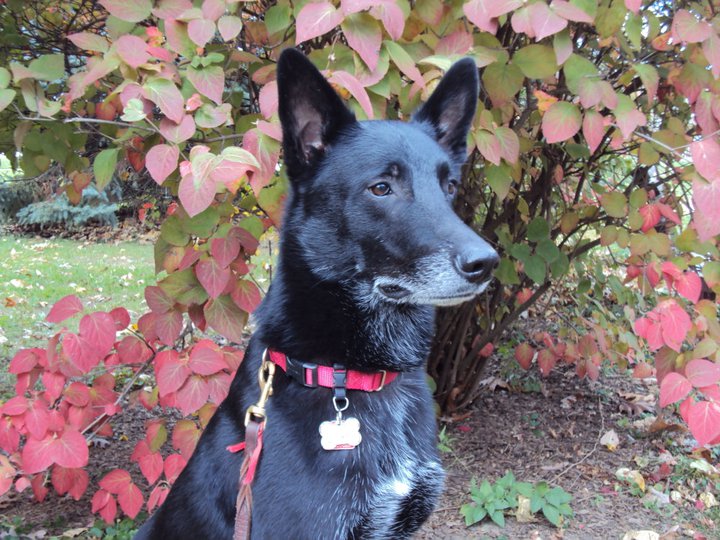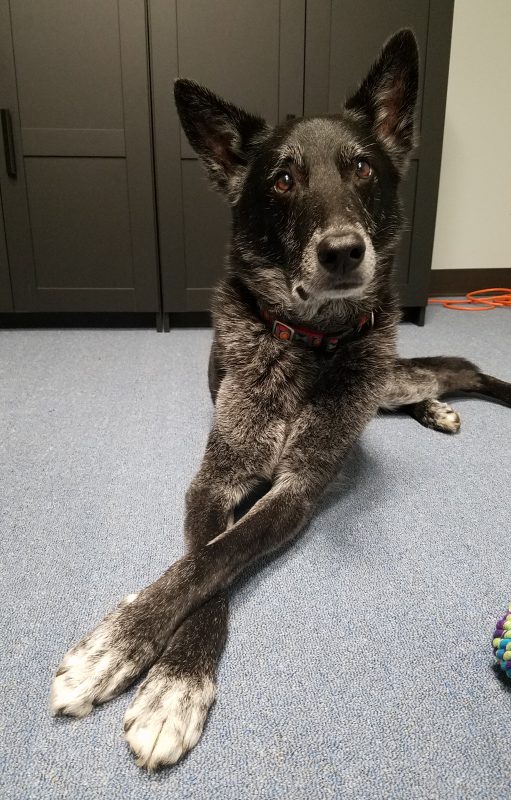Planning for the Future, A Look at Veterinary Rehabilitation Goals
By Cathryn Adolph, LVT

Locke, about 7 years old, during a fall walk.
During the rehabilitation process, we work with pet owners to set goals for their pets. After an examination, the veterinarian will identify their goals that will guide the process to obtain the long term goals set by the owners. Rehabilitation goals should be obtainable based on the individual’s medical status, age, breed, conformation, and current level of strength, balance, and coordination. I will take a look at the goals that I have for my dog, Locke, and the skills he needs to reach those goals.
My Dog, Locke
Locke is a 10 year old, German Shepherd dog mix. He has a history of cranial cruciate ligament injuries (CCL, read more on CCL injuries here). The right CCL tore at 4 years of age and the left at 6 years of age, both of which were repaired surgically. Radiographs of his spine showed the start of spondylosis along his lumbar spine and arthritis in both knees.
My Goals for Locke
These are some basic goals that I want Locke to be able to continue throughout his life. He gets fantastic enrichment out of the following activities. These goals may have to be re-evaluated, altered, or even eliminated as he ages.
- Walking for 20-30 minutes in the neighborhood (multiple large hills), currently he is a little sore after a 20 minute walk
- Able to take 1-2 short camping trips with the family a year; currently he is stiff for approximately 2 days after our return
- Continue to use the stairs independently
- Earn his Novice Trick Dog title
Rehabilitation Team Goals
Now that we have owner goals identified, it is time to apply the rehabilitation team goals. During rehabilitation therapy some of our goals include decreasing pain, increasing or maintaining range of motion in joints, correcting improper weight bearing on limbs (if present), increasing flexibility, increasing endurance, and strengthening of the truck and limbs.

Locke, just before his tenth birthday.
Combining the Two
The goals set by both parties sound very different from one another. However, the rehabilitation goals help me, the owner, reach mine. Let’s examine it goal by goal.
- For long walks Locke will need strong hind limbs with good range of motion to power up the hills. A strong core will keep his back supported. To build endurance, we will start small and build up by going for longer distances and times.
- Good pain management will help Locke going through camping trips. With improved strength and endurance, he will be able to cope with increased walking and less sleep while on camping trips.
- Just as with hills, a strong core and hind limbs will help Locke continue to use the stairs independently.
- While training tricks, Locke will follow basic commands such as heel, sit, down, and stand from a sit or down. He needs not only good posture in a sit and down, but hold that position while on potentially slippery flooring. A strong core is essential to achieving this goal, as certain tricks can be physically demanding for an untrained dog.
Small Steps
When working towards any goal, it is important to set short term goals along the way. With a goal of the 30 minute walk, I may be disappointed if we only walk 10 minutes. However, if those 10 minutes are pain free instead of Locke being sore afterwards, I would have missed a milestone.
